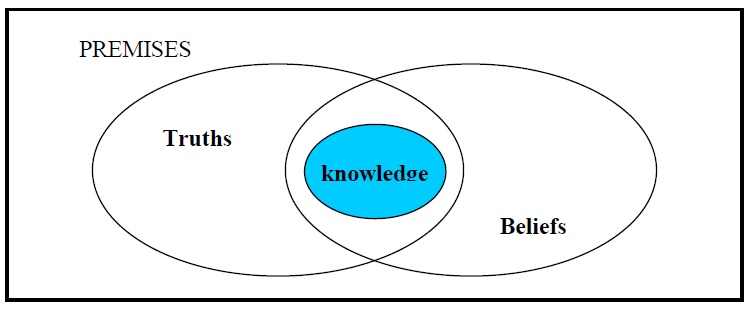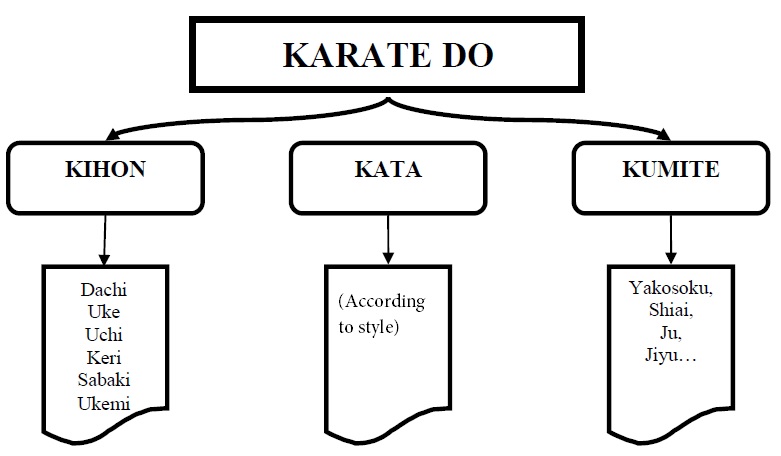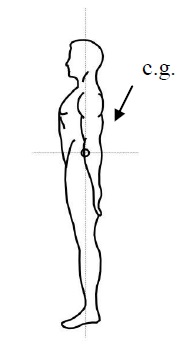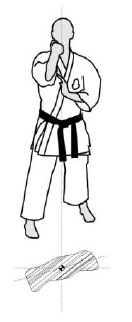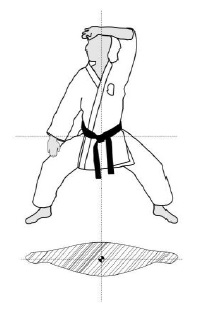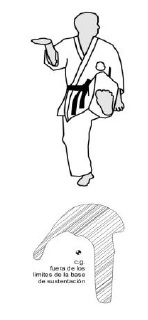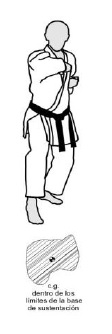Scientific Category by Combat arts
By Pablo Edurado Scurzi
Abstract:
Science and art are similar. The novel scientific theories are not the automatic result of tedious data collection. The realistic view of the world with the idea of approximation to the truth, are essential for understanding the science like phenomenon.
When we say that science and art are often similar and linked, we do so from the conviction that both require the creative power of the human intellect. It is the idea of approximation to the truth, perhaps the most important idea of scientific theory.
The idea of truth is evident in the existence of Karate Do as human development.
My thesis lists at least a general law, 5 principles and several proposals that identify Karate Do as an object of study. Finally, the approach to truth, warns us of the ability to falsifiability.
In our study case we have two key questions: is it possible to do Karate Do without meeting some of the principles embodied in the thesis? Is it possible that the Science of Karate Do not meet any of them?
We believe we can talk about the birth of a KARATE DO science from the moment we understand this as the reasoned treatment, discussion, theorization of a pragmatic and empirical knowledge of the Budo.
I. INTRODUCTION:
Every practitioner at some point in their journey through the discovery of KARATE DO, will find the question: Our activity, is it a sport, an art or perhaps, in the light of current knowledge, we could talk of a Science of unarmed combat?
These aspects are they contradictory?
In my article “Arts, Sport and Kime” published in the journal “Shin 11,” is raised the coexistence of several factors linked to human physical activities within the Karate Do. That work redefined this human activity detaching it of the mere contest, bringing it closer to art as a means of achieving certain standards of harmony and beauty.
A later reading of this monograph sparked another question in my personal journey of discovery: is not Science in itself, an Art?
In this situation, the question: KARATE DO is a Science?, would soon appear and so I decided to search, compare and determine what makes of a human activity a science, or in other words what is science and where is the traditional contemporary KARATE, within this context.
This discipline of ancient origin, in the light of current knowledge is, in fact, studied as history, biomechanics, philosophy, psychology, sociology and of course strategy, tactics and technique.
According to Plato, knowledge is a subset that is formed at the intersection of the sets of Truth and Belief, and underlying turn into a “sea” of premises. (Plato, The Republic)
Similarly our research explores the sets of values that “float” in the sea of ordinary knowledge, how they intersect and are born in the light of these unions.
As such, we will address this argument from various angles.
II. DEVELOPMENT:
Real problem
When we mentally represent the notion of martial art, we come to memory concepts such as:
- Discipline
- Respect
- Hierarchy of knowledge and experience
- Perfection in technical executions
- Inner search
- Violence
However, if it is true that in so-called martial arts these aspects are weighted, the fact remains that in all sports, to a greater or lesser extent, they are present, and this does not make it martial arts and much less science.
The confusion is compounded when we discovered the intellectual and artistic aspects of our activity and its direct link with the need to achieve a cosmological vision of all scientific knowledge. Arts, Sport and Science … How far apart these concepts can be when so often limit?
Investigation questions
Our questions:
- Karate Do is a sport, is an art or perhaps, could speak of a science of unarmed combat?
- Are these aspects contradictory?
- Is not Science in itself, an Art?
- KARATE DO is a Science?
Research Problem
Does KARATE, in view of current knowledge, is a science?
Kind of investigation
It is a non-experimental exploratory research, based on a qualitative methodology.
Objectives
General objective:
In relation to Combat Arts as an object of study of social sciences and natural sciences, those who study the objects and facts are part of the human habitat.
Specific goal:
Sort the current knowledge of the KARATE DO, so leaving the empiricism that marked him from birth, seeking to know the causes, contents and laws that govern it.
Purpose:
Our purpose is the pursuit of pure knowledge through the discovery of the essential characteristics of the object being studied, linking it to an independent qualitative variable that we understand as the concept of Science.
Referential framework
We limit our work to the analysis of Okinawan fighting arts, practiced and studied with a deep sense of search and open for those willing to test their personal opinions through fundamental plausible of corroboration.
Theoretical framework
Immediately when we talk about combat, it comes the idea of conflict, irrationality and this undermines our claim to give a scientific character at KARATE.
The subjective concept that Combat Arts should be associated with the particular idea of “irrationality” comes from the German Enlightenment.
According to this line of thought, the reason manifests itself only as an “intellectual power” which at best, is reflected in the articulated language, ie the dialogue.
This idea, which could be considered natural concept of the current prevailing globalized capitalism, tends to identify rationality with dialogue and understood as “irrational” all non-verbal behavior that includes some kind of violent manipulation between individuals or opposing groups. It is likely that this comes from the metaphysical conception of angelic societies which prompted the Judeo-Christianity in the West, however this demonstration, exceeds the possibilities of treating this particular job.
The real rationality is the human rationality, of corporeal subjects, endowed not only larynx and ears, but hands and feet as contact elements with its surroundings, but especially gifted operative conduct, conduct that involves the intervention of striated muscles. These allow: the movement; adaptive phenomenon that requires the processes of perception, processing, storage and motor response, typical of the beings, who have adapted to a medium and persist in.
Results then, from this simple analysis, totally free claim to reduce reason to the larynx: if I am in front of an individual at the time that he tries to give me a stab, the “rational” will not give a philosophical questioning about the nature of the murder, or his ethics or aesthetics, but give a strong blow and deflect the dagger from the path initiated and we assume fatal.
We are not justifying violence, we mean that it exists as a strategy for modification of the human environment and is a constant in the history of living species on the planet. The man rationalized, studied, perfected and discovered the true beauty inherent to specialized activities, stripping it of its original intent. In order to understand the processes that lead to our further reasoning, we must define a framework circumscribing the objects of study to compare them.
Methodological framework
The thesis of Carl G. Hempel stated in “The logic of explanation” says that the principles of the explanation generated of physics, also apply to Social Sciences.
Then we compare, under these principles, the historical developments that culminated in science on the one hand and KARATE DO as we understand and teach it today. This will allow us to define general laws applicable to our object of study and subsequent verification of this thesis.
SCIENCE
We define “science” as knowledge of things by their principles and causes. Reasoned knowledge, methodically trained and ordained, which is a special branch of human knowledge. (Ameba Great Illustrated Encyclopedic Dictionary, Ed. Bibliográfica Argentina, 1969)
All scientific concepts, as theoretical as they may seem, are an apply principle that within that area behooves the search for a truth potentially falsifiable.
Notwithstanding the dictionary type definitions, how can we link variables; Science on the one hand, independent variable and on the other, the concept of Combat Arts or Budo, clearly identified in KARATE DO, as a dependent variable.
A first approach to Science, presented as a way of understanding the world through refutable hypothesis, which are extracted by logical reasoning or experiments, consequences not known before establishing these hypotheses and, as pure notion, were shaped during the renaissance.
In Europe, Galileo Galilei experimented those who questioned the Aristotelian/Ptolemaic view of reality (Copernican Letters, Letter of Mr. Galileo Galilei, Academic Linceo, written to Mrs. Cristina de Lorraine, Grand Duchess of Toscaza). Before, if you wanted to know something about the world around you, you asked the church. It would give you an answer. If you dared to question, your future as a living entity was at the mercy of two possible outcomes: your excommunication after being tortured, or slow burning at the stake after being tortured.
Galileo, (Tycho Brahe and Giordano Bruno before), marked the timid beginning of the search for answers to any questions but through personal experience, and found that response could be checked, rejected or subjected to further analysis. (Mari Antonio Beltran, Galileo, Science and Religion, ed Paidos Editions, 1999), (Bertolt Brecht, Galileo Galilei, ed. Lozada, 1969)
Robert Ingersoll during the second half of the nineteenth century dared to denounce: “With all questions answered with the word ‘god’, scientific research is simply impossible” (R. Ingersoll, On the gods and Others Essays, ed. Prometheus Books, 1872).
In particular were the positivism of August Comte and then the logical empiricism of Ernest Mach, who created the foundations of the social sciences, in rejecting verbal metaphysics late nineteenth century, in the conviction that thought should be governed only by relations and laws. For these epistemologists, mankind went from a theological and abstract state, to the Metaphysical state and, finally, to the Positive state, finding in science an authentic way to govern their lives. (August Comte, Discourse on the positive spirit, ed. Aguilar, Buenos Aires, 1965)
Thus science emerged from “pre-scientific” knowledge, ie before the invention of the critical method and, slowly strengthened itself.
In these terms it seems that philology or cosmology, for example, would fall outside the categorization of science, since it has not yet been able to conduct experiments to confirm say, unlimited finitude of the universe or the Higgs boson (…not yet).
It is that actually we do not believe that science can be summed only round the scientific method. Science required and requires creativity, the creative genius of man. This enabled him to solve new questions with innovative technologies. Einstein, for example, did not perform experiments to formulate his General Theory. His genius was to make use of new mathematical tools (tensioners) to visualize the consequences of its postulates, and all made in the confined abyss of his brain. (Banesh Hoffmann, Albert Einstein, Creator and Rebel, Viking Press Inc., London, 1983)
Science is an attitude to the world. It is to seek the truth, through theoretical/experimental verification of the stated hypothesis, it is the body of knowledge obtained through observations, reasoning, methodological system of knowledge in any field. It is the orderly and systematic way to seek knowledge and the causes and laws governing it; It is to seek solutions and prefer simpler to exist several possible waiting until it can be disproved. It is to apply known principles and deduce the odds of success against new problems. Science is the creative power of human reason to explain at least temporarily, what amazes us. The mere relationship hypothesis/experiment does not explain how to have great ideas. Science is to take the step in the direction of possible consistent solutions without waiting for these congruencies, are the humanly expected.
Now, the scheme:
- Pose the problem
- Reasoning of Solutions
- Verification of results and possibilities of occurrence
It contains both, the scientific method as the theoretical genius and this, can be categorized as a guiding principle of science itself.
Identifying the problem is the ignition spark for any subsequent scientific analysis.
Karl Popper said: “… any scientific development can only be understood admitting that it starting point is a problem or, as the ancient Greeks say: an admiration.” (Popper, Karl R., The responsibility of living, Editorial Altaya, 1998, pg 20).
This elementary reasoning led to the raise of our introduction and we can consider it as the first item of our Popperian scheme.
Then, in the light of current knowledge: is KARATE DO, understood as a broad set of knowledge ordained, a science?
Let look at dependent variables.
KARATE DO
The Combat Arts bring us closer to one of the inherent characteristics of the human species: violence. However, they managed to transform quickly through certain mechanisms that allow, after recognition of the problem, its subsequent relativization.
Violence is always linked to fear (in the absence of specific diseases), and fear to the ignorance of the problem.
Daily face to the problem systematically, methodological and controlled, dispels fear and violent reactions it generates. (Thomas Hirsch, Globalization and Nonviolence speech in Lima, 2002).
There are three possible reactions to fear: we become paralyzed before it, run in the opposite direction or we face it. Combat is a way to deal face to face with it, perhaps its most rational expression.
The man can barely walk and define their social space of incumbency, generates aggressive gestures against anyone who potentially compete in the use of that space.
The sequence “eat, walk, fight,” is perfectly suited to define the behavior of any higher species, including man, “… This happens throughout the animal kingdom, from which man would not be excluded …” answered Sigmund Freud to Albert Einstein in his magnificent letter of 1932. (Sigmund Freud, why the War, Collected Works, v. III, ed. Biblioteca Nueva Madrid 1968).
In fact, in this last stage of the sequence, the human species arrives without requiring particular levels of cortical perception, perceiving even before the full development of reversible thought (understanding of the cause-effect). This natural aggressiveness even will be increased, without limits because “… the law was originally brute force and… (man) cannot renounce the support of force.” (Sigmund Freud, Why the War Works , v. III, ed. Biblioteca Nueva Madrid 1968).
The Combat Arts are the representation of what we fear, and also the desire to overcome it. Its practice involves the controlled deepening confrontation with what most frightens us internally. This constant feedback, finally culminates in the mastery of the body and the relativization of fear in a broader sense. Of course, this process takes years to complete, while the total mastery of the art, as the absolute knowledge, never arrives.
KARATE is an unarmed combat art from the Okinawa island, current prefecture of Japan, but it is also an Art of bodily expression, which generates in those who practice it useful mechanisms for channeling violence, either through ancient choreography of pure technical (Kata), or combat simulations controlled in free sparring (Kumite).
Anyway, the possibility to express it, is present and this is what characterizes it as art, provided it is the pursuit of beauty, the objective of this human expression.
The ancient traditions of the Combat Arts, were immersed in the confusion of all settlement and configuration process, which in the case of KARATE, awoke in the late nineteenth century.
In the last forty years, the flood of unreliable information and the emergence of hundreds of systems of fight like “fast food”, born under the criterion of “product for immediate consumption”, scupper the image that, for hundreds of years, the great Okinawan Masters had succeeded in making karate an irreplaceable teaching tool.
It is true however, that this tool was not born as such, and had a tortuous and slow development, product of various personal and social conflicts which tended both to confront men among themselves, as to “avoid” confront (edict “no sword”, reign of Ryukyuan King Shoshin 1477-1521). Gradually, practitioner being better prepared, they would pass on their knowledge and this allowed the evolution of this defensive mechanism as an Art.
So, Karate Jutsu, found his cause and faced its first major challenge in Okinawa on October 25, 1936, at the famous meeting of Grand Masters, the first, at least which has journalistic record.
The meeting took place in the lounge of Showa Kaikan, Naha city. These leaders were summoned by Ryukyu Shimpo local newspaper on a sunny autumn afternoon. (“Karatedo Dai Hokan” Kanken Toyama, Editorial Tsuru Shobo, 1960, pg 377-392. Translation of Sanzinsoo).
Present were: Chomo Hanashiro, Chotoku Kyan, Choki Motobu, Miyagi Chojun, Juhatsu Kyoda, Choshin Chibana, Shinpan Shiroma, Chotei Oroku, Genwa Nakasone, acknowledged masters of the three main villages of the island, Naha, Shuri and Tomari. Moreover a large groups of journalists who had warned the social phenomenon involving this activity itself, its originality and teaching potential.
According to the chronicles of the time, the debate revolved around the name they give to this activity, and the foundations that led to the election. However, it is clear that the importance of this meeting exceeded the mere question of nomenclature.
The practice of “Tode” or “karate” as used to be called then, already had a long history in Okinawa. But it appeared fairly organized, with no common name that accurately represent it. Also some were using a kanji that no longer referred to their relative Chinese origin (To or Kara: 唐, ancient Chinese Tang Dynasty period 618 -907 AD) but to precepts more rooted in buddhist or zen idiosyncrasy and, without doubt, a signification found in the increase of Japanese nationalism.
Karate became, from 1936: KARATE DO, or the path of personal discovery through combat Empty Hands. In kanji: 空手道.
The effect produced, the support of that group of Masters, highly respected and loved, who had already achieved timidly position for their activity in schools with outstanding results, allowing it to get out of obscurantism and develop under an artistic approach.
The introduction of Tode in schools in 1904 by Anko Itosu with his students Kentsu Yabu and Chomo Hanashiro, (both military who participated in the Japanese occupation of Manchuria) and then with Kanryo Higashionna in 1905 at the Commercial School of Naha are clear facts. It was possible because the notions of secret activity and violence which enveloped the native “Te” for years had dissolved to the light of the men who practiced it and taught in adjoining villages. These men, after years of hard training, became strong, reserved and wise men. In the Okinawan society in the late nineteenth century, this soon led to the complete understanding of the strategic role and potential of this autochthonous activity as a teaching tool.
The phenomenon by which KARATE and not the other arts of the empire won as a teaching tool in Okinawa, is beyond the scope of this work, but it certainly is linked to the fact that not only most Arts require the use of other weapons (Kendo, Iaido, Kyudo, etc.) and therefore its teaching in public schools was complicated, but, as it is the case of Judo, represented “too much” the dominance of the Japanese empire.
In Okinawa, people were still suffering the Meiji reform. The appearance of KARATE as a local development, allowed schools to bring a new vision of physical education and morality. This tool would soon cross into the schools of Japan.
It´s in these times, where KARATE was born and took its own entity as a teaching structure, but would lack a few years until the culmination of this process of settlement and overall conformation.
The Pacific War ended this introspective stage abruptly. The Battle of Okinawa was so bloody that one of every three islanders died. However the American occupation produced a curious effect on the practice of the Ryukyu Islands fighting: it strengthened.
During the years that followed the fall of Japan, common were brawls between young American soldiers and Okinawan karate-ka. With the constant beatings soldiers received, American generals became interested in this novel method of struggle using hands and feet.
Soon, with the contact between the two worlds, began a rapid process of cultural transfer. Upon returning home, some of the soldiers who had won the war of weapons, were the bearers of a new cultural phenomenon.
By 1970, the exponential growth that had suffered the number of practitioners of Karate Do, mainly because of its arrival in the United States, presented a new challenge: defining the competitive criteria that would be taken into account globally for this activity but now understood as a mere sport. In fact karate competitions started soon, but with small and limited places of practice.
Chojun Miyagi, founder of one of the characteristic styles known as Goju-ryu, had studied before the 40s, the use of certain protection gear to avoid injury, presumably usual caused by clashes common among the dojos in Japan. The lack of adequate armor technology next to being extremely uncomfortable, led to prefer limited physical contact (unthinkable concept until then), which led inexorably to the emergence of a sporting regulation and less extreme contest.
It is funny how “sports contest” seems to openly oppose the above statement where we talked about relativization of the problem, reduction of fear and violence while it entails it.
Is not sport a disguised representation of war? If karate practitioners in their practice understand the unnecessity of comparing their power and virtues, what sense has fighting sports karate?
Don´t forget that our proposal seeks to link KARATE to Social and Natural Sciences, not the Positives (Physics and Chemistry) and much less formal science (Mathematics). I mean, this work will be developed in the predictable broad spectrum of human unpredictable behavior. Further research will be necessary to clarify these issues in the field of sociology and psychology.
It is clear that those who assumed the sport commitment were generally younger, perhaps skilled technically, but evidently had not yet achieved a sustainable capacity analysis against the natural impulse generated by the contest.
In 1957 the AJKF organized the first tournament of sport karate or Shiai. But we have to wait until 1975 for the first World Karate to be organized in Long Island, Miami, United States.
The truth is that the appearance of a regulation that favored competitors on technical forcefulness, together with the possibility of promoting karate as a sport concept, gave new impetus to this activity, similar to the 1936 Okinawa effect.
Sports conception of KARATE helped greatly to its diffusion and spread. Thousands of young people came to the dojo hoping to learn the “deadly secret techniques of the East” under the guise of healthy sport.
We cannot underestimate the effect that produced the mass media who, for the decade of the 70s, informed and confused the public opinion and at the same time abused the ignorance and lack of interest in understanding the various phenomena arising daily.
Curiously this was the time of the search for identity and roots, and also the birth of sports federations and sporting individualism.
In this context was born the third generation of teachers, and now most were not Japanese, much less Okinawans; they were Europeans and Americans.
Of this third generation we learned KARATE and, 30 years after the first “world cup”, we face the challenge of rediscovering our common origin, organize their incumbencies, adapt their methodologies, study it in detail and in depth from different views and make it the object of study of social sciences and natural sciences.
We have learned KARATE as a result of our tolerance to the methodology of trial and error. Our teachers were not pedagogues and if any it was, generally used their knowledge of evolutionary and educational psychology, for after class.
During the decades of 70s and 80s, the resurgence of KARATE as a sport, come flooded with some orientalist and martial mysticism, which did not allow reassessing their teaching methods.
The beginning of the 90s coincided with the maturation of this third generation of teachers, and this brought many of them to use in their classes, concepts and knowledge hitherto unrelated to KARATE. They were training the next generation of teachers.
Many of them did not dare to do directly, but stimulated their students to internalize, to investigate, to review many of the assumptions that seemed untouchable. This was their most important legacy. It opened the door to the integration of knowledge and invited people to the difficult task of facing the new century. Today it is not possible to teach the art of combat without a significant number of knowledge related to sports physiology, didactics, psychology, sociology, history, etc. Maybe yes, in its competitive, cold and elitist look, but not KARATE as “road to self-discovery” for anyone who wants to walk it in the field of health.
In my work “Methodological Foundations of Teaching and Training Karate Do” (Inter-American Open University, 2005), I propose that the educational process can be informal but should be systematic and from a methodological cohesion framework that generates a proposal where we contemplate the “tool” and the object of transformation as a whole. So the psychophysical health of the practitioner and his own evolutionary process, are linked to the technological development of the practice.
Rereading that essay warned me about the importance of strategic planning, but not as we had lived until then, that is about an axis present/future, but in the opposite direction “Future-Present”: I know where I get, then I can define where it should begin. This is not a minor detail in the pursuit of scientific categorization of KARATE, as it approaches the second item of our popperian pose: the reasoning of the solutions.
Do they describe our variables and the problem posed? Reason together, the alleged relations.
Analysis Research
The Social Sciences are factual or empirical sciences. By studying the environment of human expressions, they study the facts, potential actions and attitudes to these circumstances. The cultural phenomena also can be explained according to the model of the Natural Sciences.
SCIENCE of KARATE DO not involves only knowing its techniques, but the whole body knowledge that comprises its history, the causes of its development, its mechanics, dynamics, methodologies, its strategy, educational scope, limits, its laws, its values, ethics and of course its technical and tactical concerns.
As such the SCIENCE of KARATE DO, should resolve the causes of its stay through the years, it should be able to predict the future consequences of its practice and study, should be able to find criteria of economy of movement make it even more efficient biomechanically, should be able to organize all the current knowledge that it has, should set up schemes where Art and Sport not collide in sterile debates, should find mechanisms training in line with the motor development of its practitioners, should complete the pursuit of knowledge and order methodically, either by pure reason or through the critical method.
The growing confidence in a science increasingly inclusive of the phenomena observed by man, was the focus of human progress. This phenomenon was waking up to the rational man over the gullible, and today moves the horizon of understanding beyond the limits of imagination, abandoning the absurd mythologies (formerly conflicting promoters of human development and only a heavy and unnecessary burden), to raise the echelon of the comprehension and allow us to face bravely the consequences of knowledge.
Previously we defined the concept of science as a whole, methodically trained and ordained reasoned knowledge that make up the vast universe of human thought and help it in its sustained development.
In this sense it is clear that astrology, alchemy or religion still occupy a place in this set called scientific knowledge, since none of these activities could tolerate the slightest logical reasoning.
For example, the presumption that the relative location of a planet at the time of birth, affect the future psychological and social characteristics of the newborn identified with a constellation of stars or zodiac sign involves thinking that some kind of baby/planet interaction existed at the time of the birth.
The only possible interactions between any object in the galaxy and we, are the light or the gravity. The light from these stars is out of the question for anyone born human that being on day or within a hospital indoors. Gravity, is a proportional field to the masses but decreases with the square of the distance (at least if we are to believe Newton), and while the planets are very large, they are millions of kilometers of the nursery room, which allows the gravitational effect of the mother, pediatrician and nurses who attended the birth, evidencing values well above those of the interaction of any component mass of the solar system that might be going on across the sky. I do not know horoscopes based on the mass of obstetricians.
However, those primary attempts to explain the world without accepting responsibilities (including responsibility that cannot be explained), undeniably were the source of many of nowadays well-known sciences, including astronomy, chemistry, theology, etc.
Similarly, the development of KARATE until the late twentieth century, led to what we now propose as the Science of KARATE DO or BUDOLOGY (Budo: Way of the Warrior, Logy: research, study)
|
DEVELOPMENT |
|
|
Science |
Karate Do |
|
Need to understand and predict the environment. Mythologies, religions. |
Need to survive personally in conflicts and wars. |
|
Metaphysics and pseudoscience |
Health, pedagogical tools, Art |
|
Scientific method, empirical positivism, Social and Natural Sciences. |
BUDOLOGY |
This parallelism between the development of critical thinking and science of Karate Do, was not adjusted in the temporal dimension, and had a variable phase shift that had to wait 500 years until the appearance of the Budo scientific concept, today at the dawn of the twenty-first century.
Language, Method & Object
One of the things that scientists do, is to look for patterns. That is, look for situations that are repeated or resemble and particularities or things that various objects have in common, in order to draw conclusions that allow us to conclude that: before certain backgrounds, certain consequences occur. (Mathematics, are you there? Paenza Adrian, Siglo XXI Editores, 2005). All knowledge that seeks to emerge from this search must tread a delicate path that allows categorically define: a Language, a Method and an Object. Analyze carefully these interests.
KARATE DO is a physical activity with clearly distinguishable components: the KATA a choreographic activity closed, technique and predictable, that can compare with a traditional dance or a beautiful soliloquy in classical literature; KUMITE an open activity of combat where the opponent makes one suit to the circumstances of unpredictable action, as in a dialectical debate, and a third element from which the above feed called KIHON, or basic technical study.
The KARATE DO SCIENCE includes not only art and the ability to express, but the general knowledge you have of it. Such knowledge would theoretically, historical and methodologically framed within the scientific field, when one studies, sorts and evaluates human activity.
This systematic study generates a characteristic technical language, essential for further treatment from the orbit of scientific specialization.
These developments become important to understand the KARATE as a necessity that was born from violence of an era, where the apparent absence of rules, promoted the use of all that would allow success. Reduce the art of unarmed combat, to a small group of techniques particularly effective for sporting combat, is paradoxically obtuse. Shiai or match is only a variant of Kumite, and with its rules, it limits the effects for the competitor and facilitates understanding of what is considered the sporting achievement or “point”. But it is clear that Karate Do is far away from to be just about shobu ippon or sanbon.
“The beginner needs to train kamae to achieve full awareness”. These were the words of the founder of Shotokan, Funakoshi embodied in his “Niju Kun”. How far is this thought of those who use their uniform just to winning medals.
That is why the study of Kumite is closely linked to the remarkable technical richness of Kata which in turn, the Kihon improves allowing the efficiency of the technical action.
This latter observation is not less, because defines itself, one of the biggest open secrets of KARATE DO, his method: KIHON, KATA & KUMITE.
In defining our variables we pose the causes of development of Combat Arts, but in light of current knowledge is no less important to define their technical incumbencies, to explore the contents and biomechanical characteristics that govern it. This valuable cultural background, legacy of the Okinawan people, allows us to compare the methodologies features, together with those social factors, that explain their permanence and development.
Biomechanical Corollaries
Biomechanical aspects of KARATE are closely linked to the paradigms of classical mechanics. It defines some basic concepts that will help us understand the relationships enunciate later.
The center of gravity (C.G.) of the human body is the point of application of the resultant of all forces acting on gravitational it. This varies according to the position adopted by various body segments. However KARATE practice needs to develop some ability to sustain such a center within the limits of the body. The exact location of this point can be found lying in a subject, by the method of Reynolds-Lovett.
Within the same equilibrium you can have greater or lesser stability. The factors that influence our equilibrium are:
- The support base
- The projection of C. G.
- The height of the C.G.
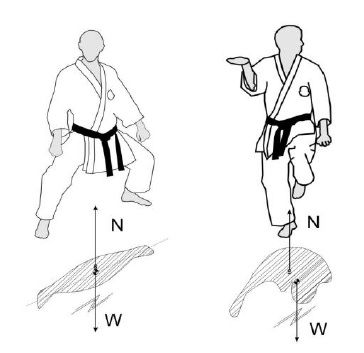 |
The balance of a system increases with the lower or closer to the support base we found it the C.G. |
The Normal
We define the Normal as the vector perpendicular to the support base, resulting from reactions of its own weight.
In the left figures are two examples: on left the normal (N) is collinear to the weight (W); on right, the point of application of the normal resulting (N) is based on the kickstand and does not match with the weight vector (W). This produces a natural imbalance (momentum), which must be compensated by the muscular effort of the hamstring thigh.
Based on these described aspects, we enunciate four characteristic principles of KARATE DO biomechanics, present in most of their blocks or series of technical execution:
- Stability: The technical gestures of attack and counterattack will have maximum efficiency when achieving stability. The maximum balance is achieved when the Normal cuts to C. G. within the boundaries of the body.
- Translation: In the translations, the C.G., must maintain a path parallel to the ground, without rising at time of action. The human eye perceives better elevation changes that changes in depth and therefore ensure the least variation of C.G at the time of change of position, hinders perception in our opponent, about our intentions.
- Normal: The blocks, strikes, thrusts and any other technique or floor standing, seek the best possible support through appropriate positions to allow the confluences of efforts and external forces, typical of the mechanical reactions gesture, be channeled through the resulting Normal.
- Breath: Breathing is low and diaphragmatic. Kiai is only the expression of final blow and not an exhibitionist resource. It is the consequence of violent exhalation of air breathed, as a result of tightening the abdominal muscles with maximum power. This helps reduce the phenomenon of Valsalva and on the other hand, the characteristic shout, will intimidate the adversary.
These maxims warn of the importance in Karate Do to keep stable and conveniently close to the ground, the center of gravity (C.G.).
The ability to produce mechanics deformation, own to the stroke of Budo, is given not only by the muscular strength of the practitioner (electro-chemical energy) and its potential to transform into kinetic energy, but its characteristics body postures designed to maximize the reactions mechanical of the support base, that support the defensive actions or counteroffensive gestures.
These concepts are what differ, from the point of Biomechanical view, the Karate Do of other sports, where the skill lies precisely in causing controlled movement of C. G, either to break the inertia, increase speed, throw or surpass elements, etc.
In particular, comparing it with other activities of combat in Karate is important to minimize the time of confrontation thus avoiding being hit. For this it is essential to maximize the technical gesture for its efficiency but also in order to develop enough energy so that only one strike is necessary.
The enormous technical variety comes from its particular original conception: everything is valid to allow one to preserve life.
Obviously the sports version was limited only to a few highly controllable skills, however it is not the case in the KATA, where the cultural heritage is overwhelming exposed.
III. CONCLUSIONS
In his essay, “The Logic of Explanation”, Carl G. Hempel, raises a number of statements that must be met to support any ideas in science. In particular we have gone through some of these paths to wonder: why the Karate Do is a Science ?, but also to describe our variables as a “explanandum”, to raise background situations within certain relevant historical setting and check that these conditions lead to a general law, can be stated as follows:
The orderly, systematic and potentially falsifiable or verifiable knowledge, applied to complex social phenomena, such as the integral development of KARATE DO, culminating in the scientific treatment of the problems that presents the phenomenon or a science that deals with it, in our case the Science of Karate Do or BUDOLOGY.
Our “explanans” is then summarized in these three declarative couples:
|
Explanans |
|
|
Science |
Karate Do |
|
The sciences were born as a predictor of the environment, in response to a need of defense against the environment. |
Karate Do born as a response to social conflicts that threatened the safety of man. |
|
The social sciences developed from primitive beliefs and pseudoscience. |
Karate Do develops as a systemized ART and then ordained as a sport. |
|
The methodological question or scientific method, results in science. |
The flow of new scientific knowledge applied to the Art comprises the Science of Karate Do or Budology. |
Within this context, the Combat Arts place them in the group of Social Sciences as a natural expression of man, while in their biomechanical and physiological issues, they belong to the environment of the Natural Sciences.
They compliments then the logical/empirical requirements of our explanation and reaffirming its deductibility, the statement of general laws governing, testability and confirmation in the light of historical events, we wish to state the second general law of our work:
The historical evolution of the social phenomenon called KARATE DO, ensures continuous future development, while the guiding principles on which this phenomenon was forged early should not be missed:
- Karate I Shin Den Shin (From heart to heart, ie Karate is learned by the sensei)
- Karate Ni Sente Nashi, Mio Mamoru (There is no first attack. Karate is self-defense and therefore the initial gesture will be a block)
- Karate Tsuki No Kokoro, Mizu No Kokoro (Heart like the moon, heart like water. Care status and own peripheral vision moonlit nights;. The crystal clear emotional state)
- Karate Mushin Waru (Empty of misconduct. Win or lose, have not meaning in the practice of karate)
- Karate Kyudo Mugen (The practice never ends. Absolute knowledge is never achieved but we approach it as much as we want)
The predictability of our claim based on these five precepts, warns of the importance of preserving the tradition that surrounds our activity (macerated tradition over the last one hundred fifty years), as an existential value.
In short; as we have seen, for something to be considered science, it will require three basic components:
- A technical language
- A method
- An object of study
Throughout this paper, we have described that the characteristic language and systematization of the method were responsible for the retention and transmission of art.
Regarding the smallest unit of analysis that some advance to justify their ends, that is the object of study, Karate Do proves that what imports is its historically known biomechanical processes for effectiveness in combat, its sporty artistic development, technical harmony and its quality as a teaching tool, but mainly imports as a SUBJECT of being a transformed transformer.
All these aspects make up the universe of Science of KARATE: The forging tool and the forger object, both as study of interest.
Knowledge about Karate Do transited hundreds of years ago from the vulgar know, then to knowledge pragmatic and now at the dawn of the twenty-first century we can affirm that has begun the stage of scientific knowledge.
The study objective, rational, widespread, systematic and fallible of all its features: mechanical, physiological, psychological, cultural and historical, make KARATE DO a scientific knowledge. As a physical activity, it was born of social violence, but its evolution transformed it into ART, SPORT and now, under this new cosmological vision a SCIENCE.
Just as the simple prescription of aspirin can relieve a headache, we do not say that the mere practice of karate can be taken as science nor be prescribed by a scientist.
Science of KARATE DO is reserved for those who are willing to face the challenge involved to test their knowledge and personal opinions, through the fundaments plausible of corroboration and criticism, practicing and studying this knowledge, with a deep sense of search.
This categorization brings with it not only the opportunity to study and discuss in the field of popperian falsification, but its possible inclusion in the official curriculum, either as a sport, use of leisure time, channeling of the “adolescent storm”, defense mechanism, etc., knowing that it is accessing a superb transformation vector in direct relation to the field of scientific knowledge, founded the new science of Budo.
Bibliography
An Interview With Hirokazu Kanazawa, Graham Noble, http://www.theshotokanway.com/kanazawainterview1.html
Angel Franco García; Física con Ordenador (curso interactivo de Física por Internet), www.sc.ehu.es/sbweb/fisica
Banesh Hoffmann, Albert Einstein, Creador and Rebel, Viking Press Inc., Londres, 1983
Bertolt Brech, Galileo Galilei, ed. Lozada, 1969
Bueno, Gustavo, “ ¿Qué es la ciencia? La respuesta de la teoría del cierre categorial”, Ciencia y Filosofía. Pentalfa, Oviedo 1995
Cartas Copernicanas, Carta del señor Galileo Galilei, Académico Linceo, escrita a la señora Cristina de Lorena, Gran Duquesa de Toscaza
Diccionario Enciclopédico Ilustrado Gran Omeba, Ed. Bibliográfica Argentina, 1969.
Camps Hermenegildo, “Historia y Filosofía del Karate”, Editorial Alas, España, 1985.
Comte August, Discurso sobre el espíritu positivo, ed Aguilar Buenos Aires, 1965.
Funakoshi, Gichin, Shoto Niju Kun
Gutierrez Dávila, M., Biomecánica deportiva, Editorial Síntesis, 1998.
Hay, J.G., The biomechanics of sports techniques, Editorial Prentice-Hall, 1993
Hempel, Carl. La Lógica de la Explicación, Editorial Paidós, Barcelona, 1965 (1988).
Hirsch, Tomás, discurso en Lima, 2002.
Ingersoll, Robert Green, On the gods and Other Essays, ed Prometheus Book, 1872
Kanken Toyama, Karatedo Dai Hokan, pg 377-392, Tsuru Shobo, 1960 .
Klimovsky, Gregorio y Boido Guillermo, Las desventuras del conocimiento científico, 1994
Klimovsky, Gregorio y Schuster Felix, Descubrimiento y creatividad en Ciencia, 2000.
Mari, Antonio Beltrán, Galileo, Ciencia y Religión, ed Paidos Ediciones, 1999.
Meter, Coles, Einstein y el nacimiento de la gran ciencia, ed. Gedisa.
McNair Ronald E., Feld Michael S. y Wilk Stephen R.; Física del Karate (Publicado en la Revista Científica “Investigación y Ciencia”, 1980)
O`Connor D.J. y otros , Historia de la filosofía occidental: empirismo, idealismo, pragmatismo y filosofía de la ciencia en la segunda mitad del Siglo XIX, ed. Paido, Barcelona, 1983.
Paenza, Adrián, Matemática, ¿estás ahí?, Siglo XXI Editores, 2005.
Platón, La República
Popper, Karl R., “La responsabilidad de vivir”, Editorial Altaya, 1998.
Rasc, P., Kinesiología y anatomía aplicada, Editorial El Ateneo, 1991.
Resnick, R., Halliday, D., Física I, Editorial Continental, 1984.
Scurzi, Pablo Eduardo, “ Arte, Deporte y Kime”, revista Shin 11, 2004.
Scurzi, Pablo Eduardo, “ Fundamentos Metodológicos de la Enseñanza y el Entrenamiento del Karate Do”, trabajo final para la Diplomatura en Deportes de Combates, UAI, 2005.
Sigmund Freud, El porqué de la Guerra, Obras Completas, v. III, ed. Biblioteca Nueva Madrid 1968.
